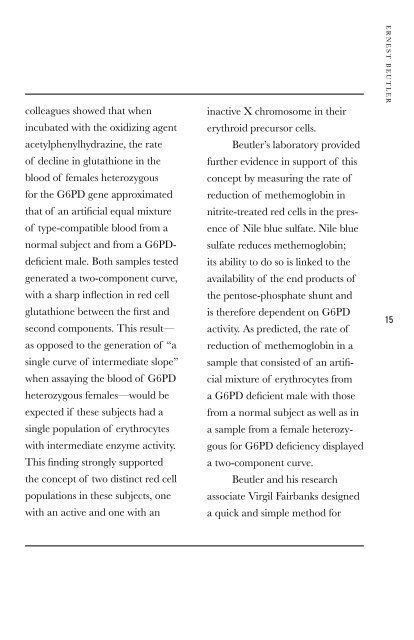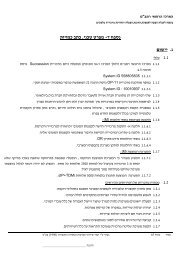ERNEST BEUTLER
ERNEST BEUTLER
ERNEST BEUTLER
Create successful ePaper yourself
Turn your PDF publications into a flip-book with our unique Google optimized e-Paper software.
colleagues showed that when<br />
incubated with the oxidizing agent<br />
acetylphenylhydrazine, the rate<br />
of decline in glutathione in the<br />
blood of females heterozygous<br />
for the G6PD gene approximated<br />
that of an artificial equal mixture<br />
of type-compatible blood from a<br />
normal subject and from a G6PDdeficient<br />
male. Both samples tested<br />
generated a two-component curve,<br />
with a sharp inflection in red cell<br />
glutathione between the first and<br />
second components. This result—<br />
as opposed to the generation of “a<br />
single curve of intermediate slope”<br />
when assaying the blood of G6PD<br />
heterozygous females—would be<br />
expected if these subjects had a<br />
single population of erythrocytes<br />
with intermediate enzyme activity.<br />
This finding strongly supported<br />
the concept of two distinct red cell<br />
populations in these subjects, one<br />
with an active and one with an<br />
inactive X chromosome in their<br />
erythroid precursor cells.<br />
Beutler’s laboratory provided<br />
further evidence in support of this<br />
concept by measuring the rate of<br />
reduction of methemoglobin in<br />
nitrite-treated red cells in the presence<br />
of Nile blue sulfate. Nile blue<br />
sulfate reduces methemoglobin;<br />
its ability to do so is linked to the<br />
availability of the end products of<br />
the pentose-phosphate shunt and<br />
is therefore dependent on G6PD<br />
activity. As predicted, the rate of<br />
reduction of methemoglobin in a<br />
sample that consisted of an artificial<br />
mixture of erythrocytes from<br />
a G6PD deficient male with those<br />
from a normal subject as well as in<br />
a sample from a female heterozygous<br />
for G6PD deficiency displayed<br />
a two-component curve.<br />
Beutler and his research<br />
associate Virgil Fairbanks designed<br />
a quick and simple method for<br />
Ernest Beutler<br />
15











